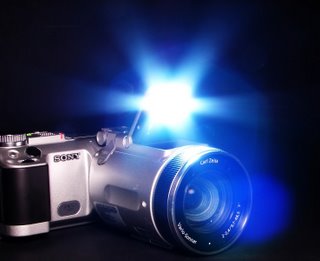 (Click on photo to enlarge)
(Click on photo to enlarge) This is the camera I used for all but five of the photos
posted here at Views Of Texas. Well, six photos now.
The F717 was revolutionary when introduced in 2002, and
except for shot-to-shot speed and high ISO quality, it
still holds it's own against the latest offerings from
the so-called 'serious' camera makers like Canon and Nikon
in it's price range, and even among cameras selling for
much more.
It's twisting lens and infrared 'night vision' features
are still unmatched, and the Carl Zeiss Vario-Sonnar lens
is sharper and has more range than lenses costing twice as
much as my whole camera.
Since Sony actually makes the sensors that are at the heart
of many cameras sold by their competitors, it made sense to
me that Sony would know best how to make the most of their
sensor's output, and nothing I have seen or read in the past
few years has made me doubt this idea.
Because it had been replaced in Sony's line by the improved
model F828 and therefore discontinued, mine was among the last
new-in-box examples to be found in all of Texas when I got it.
I had been borrowing one for a few days a month at the time,
and decided that it was THE camera for me.
If you ever get the chance to handle some of the entry-level
digital SLR cameras on the market and then play with one of
these Sonys, you'll quickly understand what terms like
"build quality" and "precision engineered" mean.
Unlike the $1000 plastic contraptions being sold by the
boatload, this camera is made with a tight and solid-feeling
magnesium alloy body, and turning the zoom ring is a
revelation in smooooth.
There will never be another camera like this one.
If you see one in a pawn shop or at a yard sale, get it.
Seriously.
So, how did I time things to take a photo of a camera's
flash going off?
Easy.
I put a borrowed Sony H1 on a tripod facing the F717, which
was lit with a single 100watt 'natural' bulb with diffuser.
On the H1 I stopped down the aperture until the exposure was
'right' with a 2 second shutter speed.
Then I engaged the 10-second timers on both cameras,
prefocused them to eliminate shutter lag, then started the
countdown on the H1 about a second before the F717.
The H1's shutter opened first, then the F717 went off in
the middle of it's exposure.
I had never tried such a tricky process before, or read
anything on the web about how to pull it off.
It just made sense at the time, and worked like a charm.


1 comment:
It's a very nice photo, and a very satisfying tribute. I have to admit, though, that I kept waiting for the line: "But, after all these years..."
Post a Comment